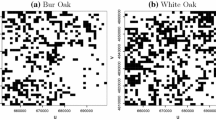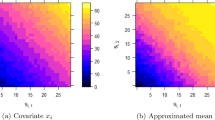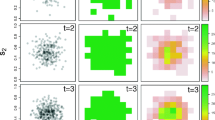Abstract
Ecologists are interested in characterizing succession processes, in particular monitoring the spread of invasive species and their effect on resident species. In situations for which binary response variables representing presence or absence of plants are observed over a spatial lattice, it may be desirable to use a model that accounts for the statistical dependence in the data, as well as the effect of potential covariates. One such model is the autologistic regression model. We show that the typical parameterization of the autologistic model presents difficulties in interpreting model parameters across varying levels of statistical dependence, and propose an alternative (centered) parameterization that overcomes this difficulty.We use the centered autologistic model to study the dynamics over time of two species, Rumex acetosella and Lonicera japonica, in an abandoned agricultural field in New Jersey, and compare the results to those obtained from using the traditional autologistic parameterization.
Similar content being viewed by others
References
Barden, L. S., and Matthews, J. F. (1980), “Change in Abundance of Honeysuckle (Lonicera japonica) and Other Ground Flora After Prescribed Burning of a Piedmont Pine Forest,” Castanea, 45, 257–260.
Besag, J. (1974), “Spatial Interaction and the Statistical Analysis of Lattice Systems” (with discussion), Journal of the Royal Statistical Society, Ser. B, 36, 192–236.
— (1975), “Statistical Analysis of Non-Lattice Data,” The Statistician, 24, 179–195.
Buell, M. F., Buell, H. F., Small, J. A., and Siccama, T. G. (1971), “Invasion of Trees in Secondary Succession on the New Jersey Piedmont,” Bulletin of the Torrey Botanical Club, 98, 67–74.
Cressie, N. (1993), Statistics for Spatial Data (2nd ed.), New York: Wiley.
Dormann, F. C., McPherson, J. M., Araújo, M. B., Bivand, R., Bolliger, J., Carl, G., Davies, R. G., Hirzel, A., Jetz, W., Kissling, W. D., Kühn, I., Ohlemüller, R., Peres-Neto, P. R., Reineking, B., Schröder, B., Schurr, F. M., and Wilson, R. (2007), “Methods to Account for Spatial Autocorrelation in the Analysis of Species Distributional Data: A Review,” Ecography, 30 (5), 609–628.
Gelman, A., and Meng, X. L. (1998), “Simulating Normalizing Constants: From Importance Sampling to Bridge Sampling and Path Sampling,” Statistical Science, 13, 163–185.
Geyer, C. J., and Thompson, E. A. (1992), “Constrained Monte-Carlo Maximum Likelihood for Dependent Data” (with discussion), Journal of the Royal Statistical Society, Ser. B, 54, 657–699.
Gumpertz,M. L., Graham,M. J., and Ristaino, J. B. (1997), “Autologistic Model of Spatial Pattern of Phytophtora Epidemic in Bell Pepper: Effects of Soil Variables on Disease Presence,” Journal of Agricultural, Biological, and Environmental Statistics, 2, 131–156.
Guyon, X. (1995), Random Fields on a Network: Modeling, Statistics, and Applications, New York: Springer.
Hoeting, J. A., Leecaster, M., and Bowden, D. (2000), “An Improved Model for Spatially Correlated Binary Responses,” Journal of Agricultural, Biological, and Environmental Statistics, 5, 102–114.
Kaiser, M. S., Daniels, M. J., Furukawa, K., and Dixon, P. (2002), “Analysis of Particulate Matter Air Pollution Using Markov Random Field Models of Spatial Dependence,” Environmetrics, 13, 615–628.
Myster, R.W., and Pickett, S. T. A. (1994), “A Comparison of Rate of Succession Over 18 Years in 10 Contrasting Old Fields,” Ecology, 75 (2), 387–392.
Pickett, S. T. A. (1982), “Population Patterns Through Twenty Years of Oldfield Succession,” Vegetatio, 49, 45–59.
Wu, H., and Huffer, F. W. (1997), “Modeling the Distribution of Plant Species Using the Autologistic Regression Model,” Environmental and Ecological Statistics, 4, 49–64.
Yurkonis, K. A., Meiners, S. J., and Wachholder, B. E. (2005), “Invasion Impacts Diversity Through Altered Community Dynamics,” Journal of Ecology, 93, 1053–1061.
Zhu, J., Huang, H.-C., and Wu, J. (2005), “Modeling Spatial-Temporal Binary Data Using Markov Random Fields,” Journal of Agricultural, Biological, and Enviromental Statistics, 10, 212–225.
Author information
Authors and Affiliations
Corresponding author
Rights and permissions
About this article
Cite this article
Caragea, P.C., Kaiser, M.S. Autologistic models with interpretable parameters. JABES 14, 281–300 (2009). https://doi.org/10.1198/jabes.2009.07032
Received:
Revised:
Issue Date:
DOI: https://doi.org/10.1198/jabes.2009.07032




